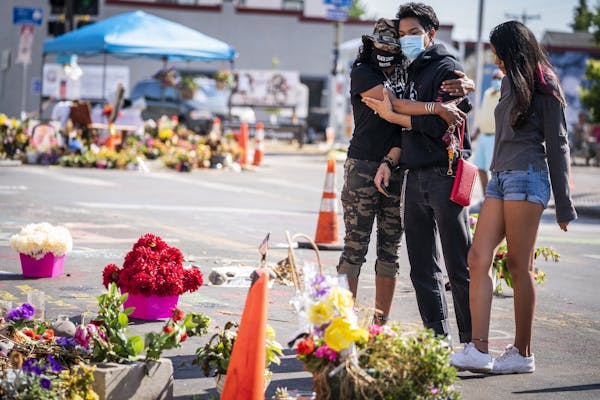One month after George Floyd was killed by Minneapolis police, the city finds itself deep in a debate over racial inequities as leaders look to both remake law enforcement and respond to a new outbreak of violence on the streets.
Adding to the strain is a massive blow to city finances driven by the coronavirus pandemic, raising questions of whether resources will be available to mount the kind of large-scale change many in the city have envisioned.
Since Floyd's death, a generations-long debate about how to run the Minneapolis Police Department has flared anew. But as city leaders turn from one crisis to the next, it's less than certain whether concrete, transformative change can be delivered — particularly for the very people of color, especially black residents, who have felt the brunt of recent emergencies.
"It's going to be a culture clash and it remains to be seen who is going to come out on top," said Michelle Gross, local president of Communities United Against Police Brutality. The chief goal, she said, should be "to cleanse ourselves of racism."
The Minneapolis Police Department has been documented to use force disproportionately on black residents. The fiery riots following Floyd's death were focused in neighborhoods known for vibrant immigrant communities. While full demographic breakdowns aren't yet available, many of the shootings currently plaguing the city are happening in areas where people of color live. And state health officials say black and Hispanic Minnesotans have been infected with coronavirus at disproportionately high rates, mirroring the national trend.
"We, as city employees, are daily keeping the priorities of those communities, not just in our minds, but in our hearts," City Coordinator Mark Ruff said at a wide-ranging news conference on Thursday, the one-month anniversary of Floyd's death.
Efforts to reform the Minneapolis Police Department long predate Floyd's death. Department leaders offered additional training. They tried, with mixed success, to diversify its force.
The Minnesota Department of Human Rights is investigating the Minneapolis Police Department in the wake of Floyd's death. The city and state negotiated a deal to ban officers from using chokeholds and neck restraints, to strengthen requirements to intervene in excessive force cases and increase transparency in some police discipline cases.
Additional terms will likely be hashed out in court in the coming weeks, and the city will submit to the state a list of laws that it believes impede its reform attempts.
Some police reform activists worry about whether the state will act. The Legislature left a special session this weekend without approving measures to increase training and change arbitration, among other proposals.
While the state investigation proceeds, City Council members are debating how to change the department.
Nine City Council members vowed earlier this month to "begin the process of ending" the Minneapolis Police Department. On Friday, they are scheduled to consider a measure that would not eliminate police but place them under the umbrella of a larger Community Safety and Violence Prevention Department. The measure would ultimately need approval from voters.
Many cities that have reduced police forces have also increased funding for social services and violence prevention programs. But the coronavirus pandemic left the city with a shortfall of about $165 million.
Current violence prevention efforts have struggled to keep up with a surge in shootings that left more than 100 people injured since Floyd's death.
Sasha Cotton, director of the city's Office of Violence Prevention, said there are plans for emergency meetings with some community groups and increased efforts to meet with gunshot victims who come into Level One trauma centers.
Cotton says she believes several factors are contributing to the violence. Some of it appears retaliatory, she said. She noted that some lost jobs during the pandemic and unrest, and they "are feeling a deep level of desperation," and that others were released from jail or prison "at an expedited rate" due to both crises.
"We really do feel like ... this is a perfect storm," she said.
While the city copes with the crises, it's seeking help from the state and federal governments — both to cover its own costs and help local business owners who struggled first with pandemic-related closures and then with destruction during the unrest.
The city is still tallying the damage inflicted after Floyd's death. As of Thursday, it knew of more than 1,000 storefronts that had been damaged. Of those, 53 buildings were destroyed.
Many were located along Lake Street, known for its immigrant-owned businesses. Though not the epicenter of the riots, West Broadway, the site of some recent shootings, also saw a string of businesses looted or damaged.
City officials are working with the state and Hennepin County to seek disaster declarations. One would ask the Federal Emergency Management Agency for assistance repairing public infrastructure and another would open up a small loan pool for businesses.
Decisions about federal aid to help with riot recovery have been inconsistent in the past. To bolster their case, city officials are asking business owners to report their losses, particularly ones that are not covered fully by insurance.
As they move forward, city officials have promised to include communities of color in the recovery — and to push their counterparts at the state level for changes in laws, in hopes of decreasing disparities in both policing and other aspects of life.
"I can't speak for what's in the legislators' minds," said Velma Korbel, director of Minneapolis' Department of Civil Rights, when asked about the prospects for police reforms. "But I can tell you that the moment is now, and I think we all understand the urgency to make the changes demanded by the community."
Liz Navratil • 612-673-4994

Want to share info with the Star Tribune? How to do it securely

'Safe recovery sites' would offer syringes, naloxone and more to people using drugs. The plan could be in peril.
New Minnesota GOP leaders seek peace with party's anti-establishment wing

Who is Republican Lisa Demuth, Minnesota's first House speaker of color?

